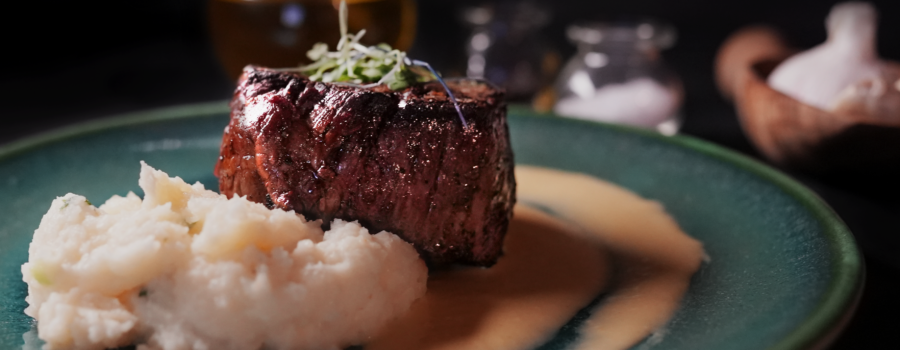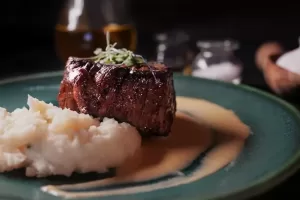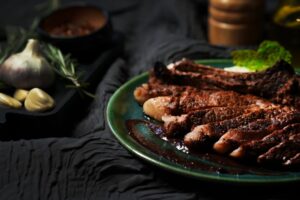Do you want to impress your guests with perfectly cooked steaks at home? The key to mastering steak lies in knowing the right temperatures for the ideal doneness. From rare to well-done, each level offers a unique experience. Learn the precise details of each steak temperature and how to cook the ideal medium-rare piece.
Whether you’re a beginner or a grill pro, these tips will help you serve up steakhouse-quality meals that are sure to wow your crowd.
Understanding Steak Doneness Levels
Reaching the perfect internal temperature is not just about taste—it’s about safety, too. Undercooked meat can lead to foodborne illnesses while overcooking can rob your steak of its juiciness and flavor. To get it just right, use a reliable meat thermometer and follow a steak temp chart. Whether you prefer a digital instant-read or a classic dial thermometer, checking your steak’s internal temp ensures precision every time.
Blue-Rare
A blue-rare steak is seared briefly over high heat, leaving the center cool and nearly raw. With only a light sear on the outside, the inside remains mostly uncooked, delivering a raw, meaty flavor and exceptionally soft texture. This style is best suited for high-quality, predominantly lean cuts of meat, where the tenderness isn’t compromised by the short cooking time. Cuts like tenderloin or sirloin are ideal, while larger muscle group cuts, such as Chuck, Brisket, and Flank, should be avoided. For steak connoisseurs craving a bold and unique experience, aim for an internal temperature between 115 and 120°F to achieve the perfect blue-rare steak.
Rare
A rare steak is seared on the outside with a dark red, cool center. This level of doneness is the right choice for those who enjoy a meaty flavor and a soft, juicy texture. For a steak to be classified as rare, the steak temp must lie between 120 and 125°F.
Medium Rare
Medium-rare steaks are warm with a red, firmer center and a perfect sear on the outside. Known for being incredibly juicy and flavorful, this level of doneness strikes the ideal balance between tenderness and taste. The slightly firmer texture still retains the natural juices, which enhances the steak’s flavor without being too raw or too cooked. This makes medium-rare the most popular choice among steak lovers because it offers the best of both worlds—succulent, melt-in-your-mouth bites with a satisfying seared crust. The ideal medium-rare steak temp should be between 130 and 135°F, making it the sweet spot for most steak enthusiasts.
Medium
When a steak has a hot pink center and is seared on the outside, it is cooked to a medium temperature. It offers a balance between juiciness and the solidity of the meat, making it the ideal steak temperature for those who want a tender bite without any bloody appearance. A steak is considered medium when its internal temperature is between 140 and 145°F.
Medium Well
Steaks with a slightly pink center and a larger brown exterior are cooked medium-well. This level of doneness is ideal for those who prefer a firmer texture while retaining some moisture and juiciness. A medium-well steak should reach an internal temperature between 150 and 155°F.
Well Done
Despite the bad rap they often get, well-done steaks can still be tasty when cooked right. They are characterized by their brown, fully cooked center with no trace of pink. While you lose some juiciness, a well-done steak can still be enjoyable if kept from becoming too dry. For a well-done steak, you’re aiming for an internal temperature of around 160°F or more.
Tips for Cooking a Medium Rare Steak
Every steak aficionado knows the allure of a medium-rare steak’s perfect blend of juicy flavor, tender texture, and inviting warm, pink center. With the following steps, you can replicate a steakhouse-quality medium-rare steak right at home.
Choosing the Right Cut of Steak
The quest for a mouth-watering medium-rare steak starts with choosing the right cut of meat. High-quality, well-marbled steaks such as ribeye, sirloin, or T-bone are excellent choices for this level of doneness. The fat marbling enhances the steak’s flavor and keeps it juicy during the cooking process.
Preparing the Steak
Before you start cooking, let your steak reach room temperature. This promotes even cooking and helps you hit the ideal medium-rare temperature. To enhance the natural flavor of the meat, use a simple rub of salt and pepper or any seasoning of choice. Apply your rub for at least 40 minutes before cooking to allow the salt to penetrate and season the meat internally.
Cooking Methods for Achieving Medium Rare Doneness
There are several methods available to cook a medium-rare steak, including grilling, pan-searing, or broiling. Whichever you choose, remember that the key is controlling the heat and keeping an accurate read of the steak’s internal temperature.
For grilling or pan-searing, start with high heat to create a beautiful crust, then move the steak to a lower heat to finish cooking without burning the exterior. To ensure you’re at the perfect steak medium-rare temp, insert the thermometer into the steak’s thickest part. When it reads 130-135°F, remove the steak from the heat.
Don’t forget to let it rest! Allow your steak at least 5 minutes to rest after cooking. The resting time allows the juices to redistribute, resulting in a more tender and flavorful steak.
Your Perfect Steak Journey Starts Here
Armed with this knowledge and a quality steak in hand, you’re now prepared to cook the perfect steak at home. Alternatively, if you prefer to leave the cooking to us, we’d be delighted to serve you at SEAR Black Hills Steakhouse. Our talented culinary team ensures that every cut of steak is cooked to perfection, promising an incredible dining experience.
Take the plunge and make SEAR Black Hills Steakhouse your go-to source for the finest quality steaks, whether you’re cooking at home or dining out. Get ready to enjoy the most delicious steak you’ve ever tasted!




